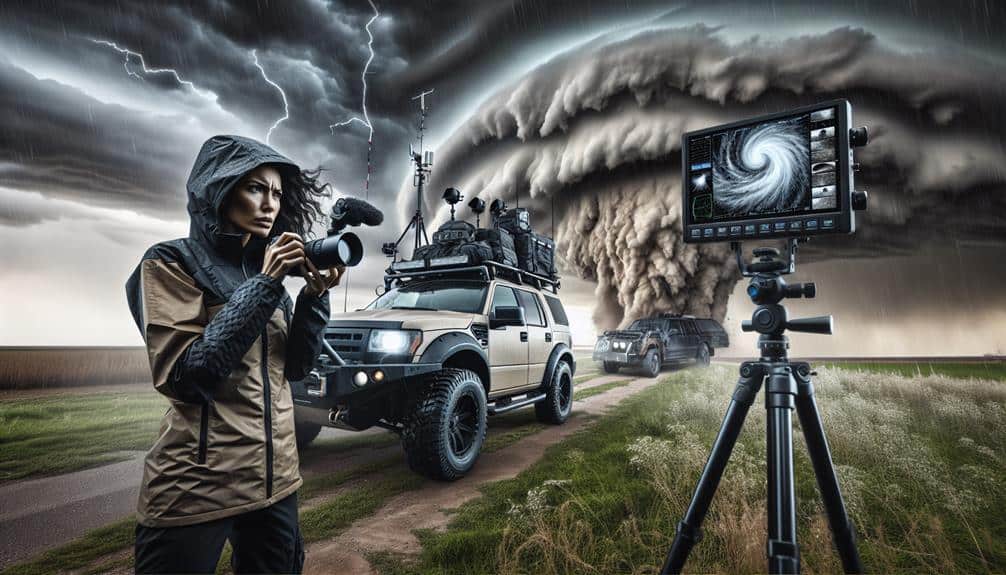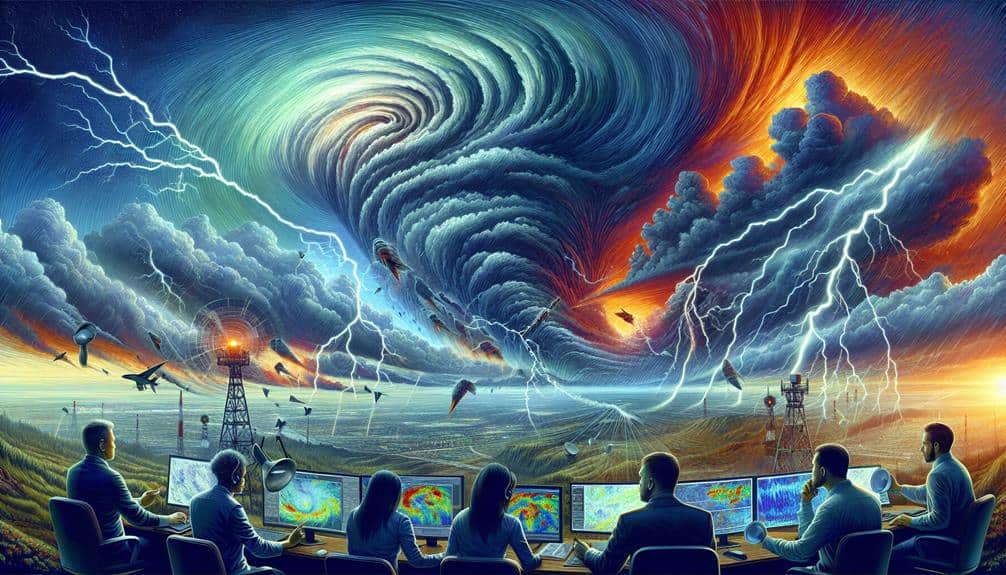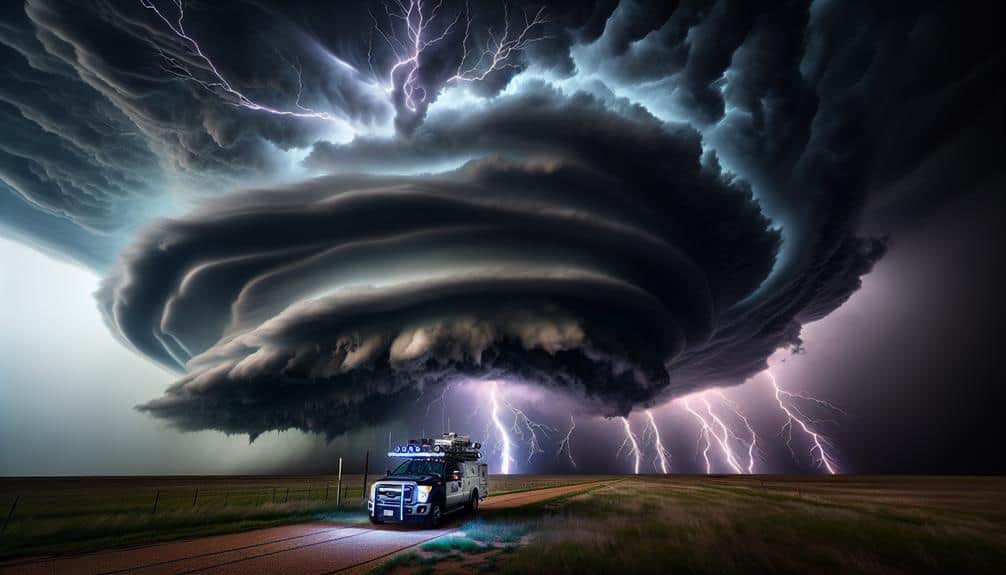Let's tackle storm chasing with important gear tips for beginners. First, we need a reliable, durable vehicle with all-wheel drive and robust safety features. Weather radios and GPS devices are essential for tracking and navigation, while satellite phones and walkie-talkies guarantee communication. For capturing storm activity, a sturdy tripod and versatile camera gear, protected by waterproof cases, are indispensable. Don't forget protective clothing, backup batteries, and emergency tools like first aid kits. Stocking up on food and water keeps us ready for extended chases. Proper training and preparedness greatly enhance our safety and chances of success. Discover more about optimizing your storm-chasing setup.
Key Points
- Prioritize a Reliable Vehicle: Choose a durable, all-wheel drive vehicle with essential safety features for navigating storm conditions.
- Carry a Weather Radio: Use NOAA frequency radios for real-time weather updates and alerts.
- Invest in Protective Clothing: Wear waterproof jackets, non-slip boots, and thermal layers for protection against harsh weather.
- Bring Backup Batteries: Ensure all your devices have reliable power sources with high-capacity backup batteries.
Reliable Vehicle
When selecting a dependable vehicle for storm chasing, we should prioritize models with high durability, all-wheel drive, and advanced safety features to guarantee peak performance under extreme weather conditions.
A sturdy chassis and reinforced body panels are essential for withstanding debris and high winds. All-wheel drive ensures superior traction on wet or uneven surfaces, which is essential when we need to navigate through rough terrains.
Vehicle maintenance is paramount. Regularly checking tire pressure, oil levels, and brake functionality can prevent mechanical failures during critical moments. Ensuring our vehicle's electrical systems are in top condition is essential, as these systems support vital components like headlights and wipers, which are indispensable in low-visibility situations.
Carrying a complete set of emergency supplies is non-negotiable. This includes a first aid kit, fire extinguisher, and a toolkit for minor repairs. Jumper cables, spare tires, and an air compressor can be lifesavers if we encounter mechanical issues far from help.
Weather Radios
Having a reliable vehicle is just one part of our storm chasing strategy; equally important are weather radios, which provide real-time updates and alerts critical for making informed decisions during storm pursuits. Weather radios operate on NOAA (National Oceanic and Atmospheric Administration) frequencies, delivering timely information on weather patterns and storm warnings. This technology is indispensable for our preparedness, allowing us to adjust our routes and tactics based on the latest meteorological data.
When we're out in the field, we can't rely solely on mobile networks, which may fail under severe weather conditions. Weather radios, however, are designed to function independently, ensuring continuous access to essential information. These devices broadcast alerts about tornadoes, thunderstorms, and flash floods, giving us the edge in anticipating weather changes and staying safe.
The portability and ease of use of weather radios make them an essential tool. Most models come with features like SAME (Specific Area Message Encoding) technology, enabling us to receive alerts specific to our location. By integrating weather radios into our gear, we harness advanced technology to stay ahead of volatile weather patterns, making our storm chasing endeavors not just thrilling but also safer and more efficient.
Effective GPS navigation is essential for storm chasers, providing precise, real-time location data essential for tracking storm movements and planning safe routes. When we're in the field, we rely on GPS units that offer high-resolution maps and dynamic weather overlays. These features allow us to pinpoint our exact position relative to a storm's path, increasing our chances of capturing critical data while ensuring our safety.
Advanced GPS systems enable us to navigate through various terrains, making off road exploration feasible. Many storms don't follow the convenience of paved roads, so having a unit that supports topographic maps and trail data is invaluable. This flexibility lets us adapt quickly, whether we're on a rugged backroad or in an urban environment.
For those of us who also enjoy geocaching adventures, our GPS units double as tools for this recreational activity. The same accuracy and reliability that assist in storm chasing make finding hidden caches a breeze.
Data-driven decision-making hinges on the accuracy of our location data. Modern GPS devices offer waypoint logging, route tracking, and real-time updates. These features are indispensable for both storm chasing and other outdoor pursuits, giving us the freedom to explore while staying informed and safe.
Sturdy Tripod
A strong tripod is essential for capturing stable, high-quality footage of storm activity, ensuring that our cameras remain steady even in high winds and uneven terrain. Tripod stability is key when we're documenting fast-moving storms, which often involve unpredictable and severe weather conditions.
A tripod with sturdy legs and a solid center column can withstand gusts and vibrations, allowing us to focus on getting the perfect shot without worrying about camera shake.
We should consider tripods made from tough materials like carbon fiber or aluminum, which offer a good balance of strength and weight. Tripod portability is equally important; we need gear that's easy to transport and set up quickly as storms can develop rapidly.
Lightweight yet strong tripods with quick-release mechanisms and compact designs are best for storm chasers who value freedom and mobility. Data shows that tripods with a higher load capacity provide better stability, especially when paired with heavy camera equipment.
Adjustable leg angles and spiked feet can enhance stability on uneven surfaces, ensuring our setup remains secure. By prioritizing both tripod stability and portability, we can capture the raw power of nature with precision and clarity, empowering us to share compelling storm footage with the world.
Camera Equipment
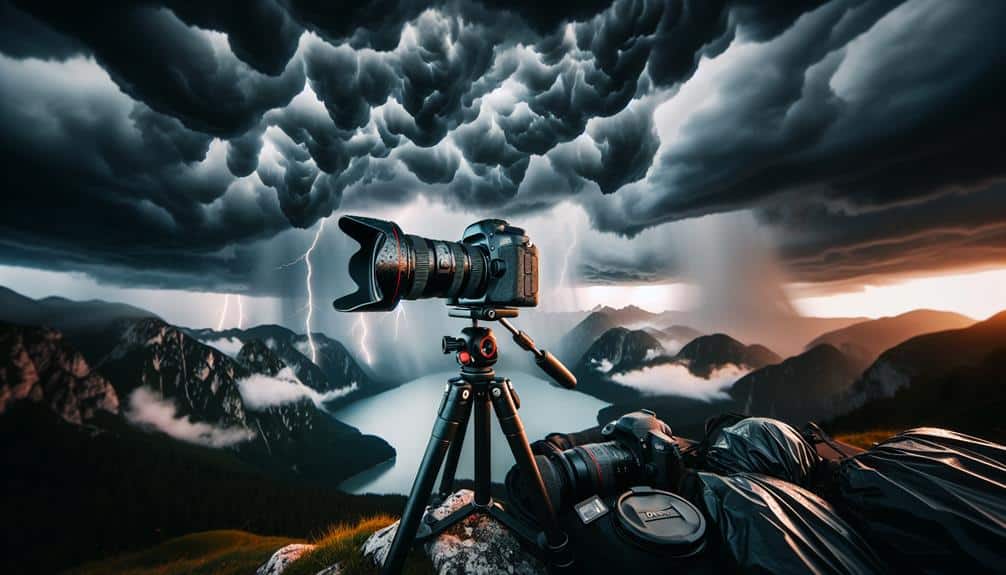
Often, the choice of camera equipment can make or break our ability to capture the dynamic and unpredictable nature of storms with scientific accuracy. Our gear must be robust and versatile to meet the demands of storm chasing. Key considerations include camera settings, lens selection, and mastering photography techniques to ensure high-quality images.
Here's what we should focus on:
- Camera Settings: Manual mode is essential. We need control over shutter speed, aperture, and ISO to adapt to rapidly changing light conditions. A fast shutter speed captures lightning, while a slower setting captures storm structure.
- Lens Selection: Wide-angle lenses (14-24mm) are ideal for capturing expansive cloud formations and storm fronts. Telephoto lenses (70-200mm) help isolate distant tornadoes or lightning strikes. Always carry a variety of lenses to adapt to different scenarios.
Investing in the right camera equipment and honing our skills can greatly enhance our storm-chasing experience, allowing us the freedom to document these awe-inspiring natural phenomena with precision and artistic flair.
First Aid Kit
In order to carry a well-stocked first aid kit is vital for addressing potential injuries and medical emergencies while storm chasing. Given the unpredictable nature of storms, it's important to be prepared for various scenarios. Our first aid kit essentials should include adhesive bandages, antiseptic wipes, gauze pads, adhesive tape, and a CPR mask. These items are fundamental for treating cuts, scrapes, and more serious injuries until professional medical help is available.
Organization within our first aid kit is paramount. By compartmentalizing items, we guarantee quick access during emergencies. We should use labeled sections to separate medications, wound care supplies, and emergency tools like a tourniquet or shears. This systematic approach reduces response time and increases the efficacy of our interventions.
Training is another important component. We must familiarize ourselves with the contents of our first aid kit and undergo proper first aid and CPR training. This training empowers us with the skills needed to handle medical situations confidently and effectively.
According to the American Heart Association, prompt CPR can double or triple a victim's chance of survival. Therefore, being well-prepared with both equipment and knowledge guarantees we can chase storms safely and responsibly.
Protective Clothing

When storm chasing, wearing protective attire crafted to withstand extreme weather conditions is necessary for our safety and efficiency in the field. Our protective gear needs to balance durability and comfort, guaranteeing we can move freely without compromising on protection.
Key clothing options and accessories play a pivotal role in safeguarding us from harsh elements like wind, rain, and debris.
For peak protection, we should invest in:
- Waterproof and wind-resistant jackets: These should be lightweight yet sturdy to prevent water infiltration and shield against strong winds.
- Robust, non-slip boots: Essential for maintaining traction on slippery or uneven terrains. Waterproofing is essential to keep our feet dry and comfortable.
Scientific studies show that high-quality protective gear can reduce the risk of hypothermia and injuries from flying debris by up to 40%.
Our clothing choices and accessories must be carefully selected to ensure we remain agile and responsive. Remember, the right gear not only enhances our safety but also empowers us to chase storms with confidence and freedom.
Backup Batteries
Aside from protective clothing, having reliable backup batteries is vital for keeping our equipment operational during long storm chases. Our cameras, GPS units, and communication devices are lifelines, and their functionality hinges on consistent power supply. Portable chargers, particularly those with high-capacity lithium-ion batteries, are indispensable. They provide rapid recharging capabilities and can power multiple devices simultaneously.
Data from the National Geographic Society indicates that a fully charged 20,000mAh portable charger can recharge a typical smartphone up to six times. This autonomy guarantees we're not stranded without functional equipment in critical moments.
Additionally, integrating solar panels into our gear offers a sustainable and eco-friendly backup solution. Solar panels with a 25-watt capacity can generate sufficient electricity to recharge portable chargers over several hours of sunlight exposure. This setup is essential when we're out in the field for extended periods and conventional power sources are unavailable.
Food and Water
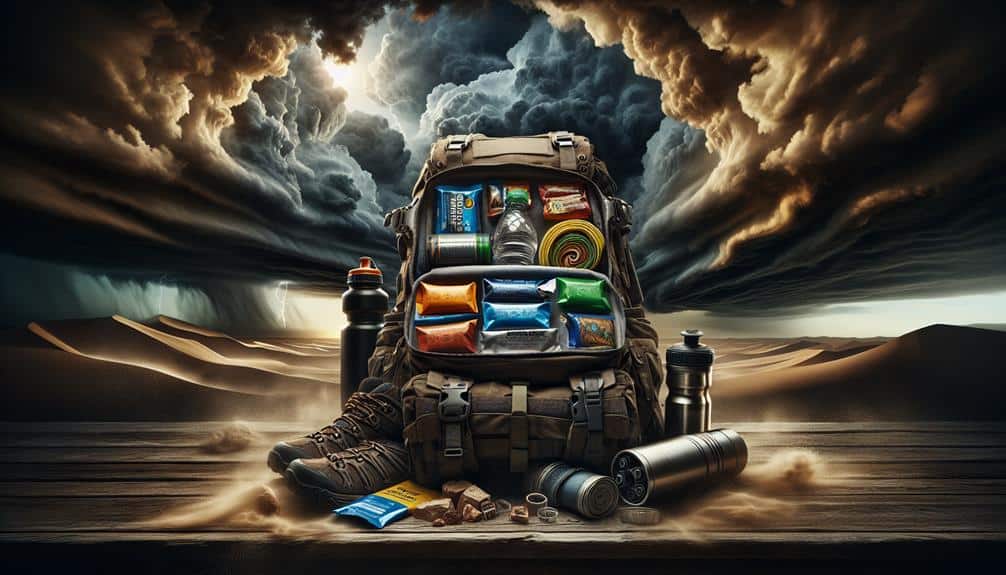
In the world of storm chasing, maintaining sufficient supplies of food and water is vital for both our safety and endurance. Long hours on the road and unpredictable weather conditions demand we're prepared.
Hydration options are essential; we need to stock up on bottled water and consider portable water purification solutions to make sure we can always access safe drinking water. Dehydration can impair our ability to make quick, accurate decisions, so we must stay vigilant about our fluid intake.
When it comes to snack choices, selecting nutrient-dense, non-perishable items is key. Snacks like energy bars, nuts, and dried fruit provide sustained energy and are easy to store.
Proper meal prep is equally important. Preparing meals in advance can save us time and ensure we've nutritious food readily available, even in the midst of a storm chase.
Emergency Tools
When we're out storm chasing, having the right emergency tools can be essential for our safety.
A versatile rescue tool, a thorough first aid kit, and reliable communication devices are non-negotiable.
These items have been shown to greatly increase survival rates and response times in crisis situations.
Multi-purpose Rescue Tools
Equipping ourselves with multi-purpose rescue tools is essential for ensuring safety and efficiency during storm chasing expeditions. These tools provide the versatility needed to navigate unpredictable and hazardous environments, greatly enhancing our response capability. Integrating multi-purpose rescue tools into our gear is a scientifically supported decision that maximizes preparedness.
Many of these tools combine essential functions, allowing us to reduce the volume of our gear without sacrificing utility. For instance, a tool that can cut, pry, and hammer can be invaluable in emergency scenarios.
Here are a few critical multi-purpose rescue tools:
- Multi-tool with pliers, knife, and screwdriver: Compact and versatile, this tool can handle various small tasks, from cutting rope to tightening screws.
- Emergency escape tool: Equipped with a glass breaker and seatbelt cutter, it's indispensable for quick vehicle egress in case of entrapment.
In storm chasing, the unpredictability demands that we prepare for a spectrum of emergencies. Having multi-purpose rescue tools alongside emergency shelters and survival kits greatly ensures we're ready for varied situations, giving us the freedom to focus on the chase itself.
First Aid Kit
A well-stocked first aid kit is important for addressing injuries and medical emergencies that can occur during storm chasing expeditions. Our preparedness in emergency response guarantees we can manage minor injuries and stabilize more serious conditions until professional help arrives.
This kit should include basics like adhesive bandages, antiseptic wipes, gauze pads, and medical tape. Additionally, incorporating items such as a CPR face shield, a digital thermometer, and a pair of tweezers can enhance our ability to handle various medical situations effectively.
Survival skills and wilderness training play a significant role in storm chasing. Knowing how to use the items in our first aid kit can make the difference between a minor setback and a major disaster. For instance, understanding how to treat hypothermia or clean a wound properly can prevent complications.
We should also include a manual that covers basic first aid procedures, making sure that everyone in our group is equipped with the necessary knowledge.
Disaster preparedness isn't just about having the right gear; it's about knowing how to use it. Regularly checking and restocking our first aid kit ensures that we're always ready to face the unpredictable nature of storm chasing with confidence and competence.
Communication Devices
To assure reliable communication during storm chasing, we need to equip ourselves with a variety of emergency communication devices that can function in extreme weather conditions. The unpredictable nature of storms demands that we stay connected to our team and emergency services.
Here are essential devices to take into account:
- Satellite phones and emergency beacons: Satellite phones provide global coverage, ensuring communication even when cellular networks fail. Emergency beacons are critical for signaling distress and can be life-saving if we find ourselves in a dire situation.
- Walkie talkies: These devices are indispensable for close-range communication among team members. With a reliable range and frequency channels, walkie talkies enable us to coordinate movements and share real-time information.
Incorporating these tools into our gear ensures that we maintain a lifeline to the outside world, no matter how severe the storm. The ability to communicate effectively can be the difference between a successful chase and a dangerous situation.
Let's prioritize these devices to maximize our safety and freedom during our storm-chasing adventures.
Frequently Asked Questions
How Do I Find the Best Storm Chasing Locations?
Imagine the perfect storm chase! We can pinpoint the best locations by leveraging weather apps, detailed maps, and local knowledge. Advanced technology and real-time data guarantee we're always steps ahead, maximizing both safety and excitement.
What Are the Safest Practices for Storm Chasing?
When storm chasing, we should prioritize emergency preparedness and diligent weather monitoring. Let's prioritize our vehicles are equipped with survival kits, maintain constant communication, and use reliable weather apps to track storm developments accurately and stay safe.
Can I Storm Chase Without Any Prior Experience?
We wouldn't recommend solo chasing if you lack prior experience. Extreme weather demands technical knowledge and safety protocols. Data shows that inexperienced chasers face higher risks. Partner with seasoned storm chasers to enhance safety and learning.
How Do I Communicate With Other Storm Chasers?
In the age of telegraphs, we'd use social media and networking for group communication. It's essential for safety to share real-time data, coordinate through platforms like Twitter, and join storm chasing forums to stay connected.
What Are the Legal Restrictions on Storm Chasing?
When storm chasing, we must follow drone regulations and make sure we have permits required for restricted areas. Local laws vary, so research and compliance are essential to avoid fines and guarantee our safety and freedom to chase.
